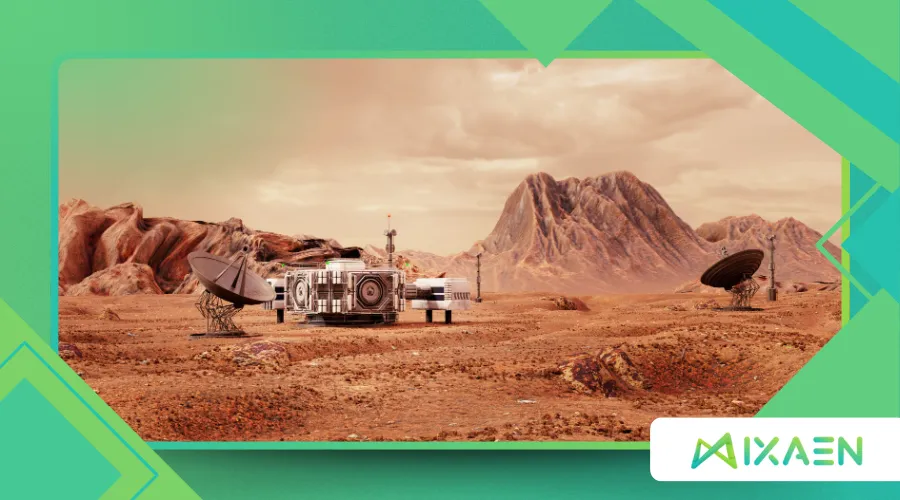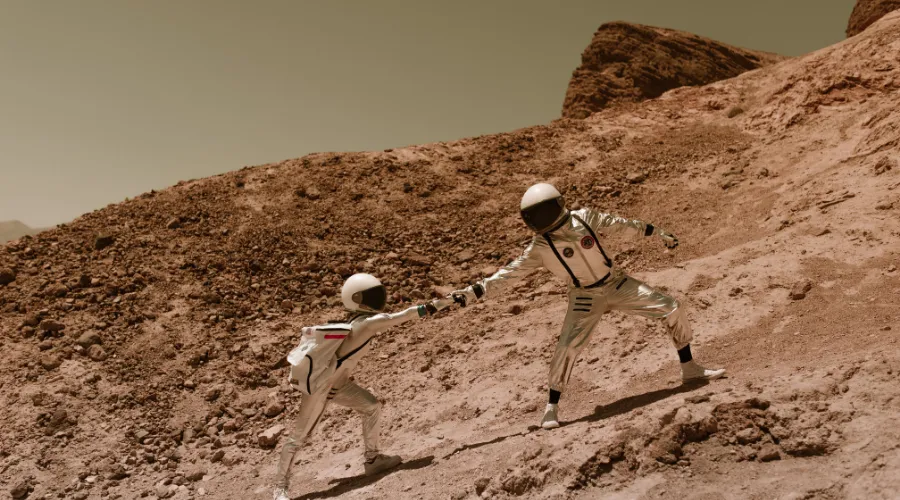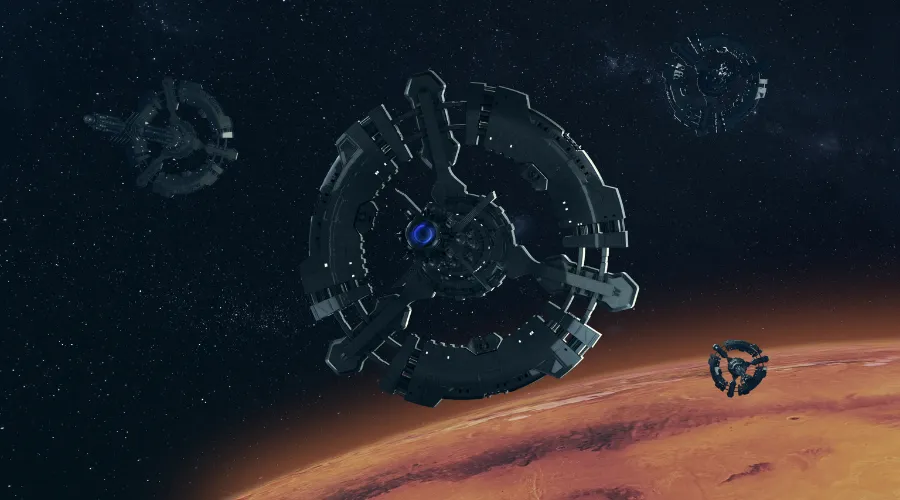Missions to Mars: The Path Toward Human Settlement

Human settlement on Mars is no longer a distant dream but a tangible goal driving global space exploration.
Anúncios
The Red Planet, with its dusty plains and towering volcanoes, has captivated humanity’s imagination for centuries, evolving from science fiction to a frontier for scientific ambition.
Today, missions to Mars are laying the groundwork for a future where humans might live beyond Earth.
This article explores the technological, scientific, and societal strides propelling us toward this audacious vision, weaving together current missions, innovative ideas, and the challenges we must overcome to make human settlement a reality.
As we look ahead, international collaborations and advancements in technology will be crucial in ensuring that our efforts to settle Mars are sustainable and beneficial for all of humanity.
The New Era of Martian Exploration
The journey to Mars has accelerated in recent years, with robotic missions paving the way for human settlement.
NASA’s Perseverance rover, which landed in 2021, is a prime example, collecting samples to study the planet’s geology and past habitability.
Its companion, the Ingenuity helicopter, demonstrated powered flight on another planet, a feat akin to the Wright brothers’ first flight on Earth.
This analogy underscores the incremental progress needed for human settlement—each mission builds a stepping stone toward a larger goal.
Meanwhile, China’s Tianwen-1 mission and the UAE’s Hope orbiter are expanding our understanding of Mars’ atmosphere and surface, creating a global effort to map the planet’s potential for sustaining life.
These missions are not just about exploration; they are strategic precursors to human presence.
By studying Martian soil, atmosphere, and water ice, scientists are identifying resources critical for sustaining a colony.
For instance, NASA’s MOXIE experiment successfully produced oxygen from Mars’ carbon dioxide-rich atmosphere, generating 5 grams per hour in 2021—enough to sustain an astronaut for a few minutes but a proof of concept for larger-scale systems.
This innovation hints at a future where settlers could breathe Martian air, transformed by technology.
Moreover, the collaboration among international space agencies is pivotal, as shared knowledge and resources can accelerate our progress toward human settlement.
Technological Pillars for Human Settlement
Building a human settlement on Mars demands breakthroughs in multiple fields.
Life support systems, radiation shielding, and sustainable energy are non-negotiable for survival in Mars’ harsh environment.
Unlike Earth, Mars has a thin atmosphere offering little protection from cosmic rays, which can increase cancer risks by 10-20% over a lifetime, according to a 2013 study published in Science.
Mitigating this requires habitats with robust shielding, possibly using Martian regolith as a natural barrier.
Energy production is another cornerstone.
Solar power, while viable, is less reliable due to Mars’ frequent dust storms, which can block sunlight for months.
Nuclear energy offers a promising alternative.
Small modular reactors, like those proposed by NASA and the Department of Energy, could provide consistent power for a Martian base.
Imagine a settlement powered by a compact reactor, its hum a heartbeat sustaining life in an alien world.
Transportation remains a critical hurdle.
SpaceX’s Starship, designed to carry up to 100 people, aims to make interplanetary travel economically viable.
Its reusable design could slash costs, making frequent missions feasible.
Picture a fleet of Starships landing on Mars, each unloading cargo and crew to build a fledgling colony—a vision Elon Musk has championed since 2016.
| Technology | Purpose | Current Status |
|---|---|---|
| In-Situ Resource Utilization (ISRU) | Produce oxygen, water, and fuel from Martian resources | MOXIE produced 5g/hour oxygen in 2021; scaling up in progress |
| Radiation Shielding | Protect settlers from cosmic and solar radiation | Concepts include regolith-based habitats; prototypes in testing |
| Nuclear Energy | Provide reliable power for settlements | Small modular reactors in development by NASA/DOE |
In addition, advancements in robotics and automation will be crucial for constructing habitats and maintaining infrastructure on Mars, reducing the burden on human settlers.
+ Mir Space Station: The History of the Pioneer of Long-Duration Missions
The Scientific Quest for Habitability
Mars’ environment poses unique challenges to human settlement.
Its average temperature hovers around -80°F (-62°C), and its atmosphere is 95% carbon dioxide, making agriculture and breathable air difficult without advanced systems.
Yet, evidence of ancient water flows and subsurface ice offers hope.
The discovery of a subglacial lake beneath Mars’ south pole in 2018 by the European Space Agency’s Mars Express suggests potential water reserves, critical for drinking, farming, and fuel production.
Scientific missions are also probing whether Mars ever supported life, which could inform human settlement strategies.
If microbial life once thrived, it might indicate conditions that could be recreated.
Perseverance’s sample collection, set to be returned by the Mars Sample Return mission in the early 2030s, could reveal biosignatures, offering clues about Mars’ habitability.
These findings will shape how we design habitats to mimic Earth-like conditions, perhaps using hydroponics to grow crops in controlled environments.
Consider a hypothetical Martian greenhouse, dubbed “Eden Base.”
Inside, rows of leafy greens thrive under LED lights, fed by recycled water extracted from subsurface ice.
This self-sustaining system could feed dozens, proving that agriculture on Mars is not just possible but scalable.
Such innovations are vital for long-term human settlement, reducing reliance on Earth supplies.
Furthermore, ongoing research into Martian soil composition will be essential for developing effective agricultural practices that could support human life.

Societal and Ethical Considerations
Beyond technology, human settlement on Mars raises profound societal questions.
Who will govern a Martian colony?
A 2024 report from the Brookings Institution suggests that early settlements might adopt models akin to Antarctic research stations, with international cooperation and shared governance.
This ensures no single nation dominates, fostering a collaborative ethos.
Diversity in settlement planning is equally critical.
A Martian colony must reflect humanity’s varied cultures, skills, and perspectives to thrive.
Imagine a linguist from Senegal working alongside a biochemist from Japan, their combined expertise solving unique Martian challenges.
This diversity strengthens resilience, ensuring the colony isn’t a monolithic outpost but a vibrant community.
Ethical dilemmas also loom.
Should we terraform Mars, altering its environment to suit humans?
Critics argue this could destroy potential Martian ecosystems, even if only microbial.
Supporters counter that terraforming is essential for human survival, potentially thickening the atmosphere with greenhouse gases.
What right do we have to reshape another world?
This question demands global dialogue before we take irreversible steps.
| Ethical Issue | Pros | Cons |
|---|---|---|
| Terraforming Mars | Could create Earth-like conditions, enabling larger settlements | Risks destroying native ecosystems; massive resource cost |
| Governance Models | International cooperation fosters peace, shared goals | Potential for bureaucratic gridlock or unequal representation |
| Genetic Modification | Could enhance human resilience to Mars’ environment | Ethical concerns about altering human biology; accessibility disparities |
In addition, engaging in discussions about the ethical implications of colonization will be essential to ensure that we approach Mars settlement responsibly.
For more insights into the ethical considerations surrounding Mars exploration, you can visit NASA’s Mars Exploration Program.
The Economic Case for Mars
Funding human settlement on Mars is a colossal challenge.
A single crewed mission could cost $500 billion, per NASA estimates, dwarfing the Apollo program’s $150 billion (adjusted for inflation).
Yet, the economic case is compelling.
Technologies developed for Mars—such as advanced robotics or life support—often yield Earth-based applications, from medical devices to renewable energy.
The Apollo program, for instance, spurred innovations like GPS and satellite communication, suggesting Mars missions could drive similar breakthroughs.
Private investment is reshaping the landscape.
Companies like SpaceX and Blue Origin are reducing costs through reusable rockets and commercial partnerships.
SpaceX’s goal of a $200,000 ticket to Mars, while ambitious, could democratize access, making human settlement a shared endeavor rather than an elite privilege.
Public-private partnerships, like those funding the International Space Station, could further distribute costs, ensuring broader support.
Moreover, the potential for resource extraction on Mars, such as mining for rare minerals, could provide additional economic incentives for settlement.

Overcoming Psychological Barriers
Living on Mars will test human resilience.
Isolation, confined spaces, and a barren landscape could strain mental health.
Studies from analog missions, like NASA’s HI-SEAS in Hawaii, show that crew cohesion and psychological support are critical.
A Martian settler might face months without seeing Earth, relying on virtual reality to simulate home or therapy bots to manage stress.
Picture “Aurora Haven,” a Martian habitat designed with biophilic principles—incorporating plants, natural light, and open spaces to mimic Earth’s environment.
Such designs could reduce stress, fostering a sense of home.
Training programs, drawing from astronaut protocols, will prepare settlers for these challenges, emphasizing adaptability and teamwork.
Additionally, creating a strong community culture within Martian settlements will be essential for maintaining morale and mental well-being.
++ Gemini Project: The Space Program That Prepared Humanity for the Moon
The Global Race and Collaboration
The push for human settlement on Mars is both competitive and collaborative.
NASA aims to send astronauts by the late 2030s, while SpaceX targets crewed missions as early as 2029.
China’s space agency has announced plans for a crewed mission by 2033, escalating the race.
Yet, collaboration is evident in shared data from rovers and orbiters, ensuring no nation operates in isolation.
This balance of rivalry and cooperation mirrors the Cold War space race, but with a key difference: Mars demands unity.
No single entity can tackle the financial, technical, and ethical challenges alone.
International agreements, like the Artemis Accords, could extend to Mars, setting rules for resource use and conflict prevention.
Moreover, fostering partnerships between countries can enhance the sharing of technology and expertise, accelerating our journey to Mars.
A Vision for the Future
Human settlement on Mars is a testament to our species’ ambition.
It’s not just about surviving on another planet but thriving—building a society that reflects our best values.
The path is fraught with challenges, from radiation to governance, but each mission brings us closer.
The 2020s are a pivotal decade, with rovers, orbiters, and private ventures laying the foundation.
As we stand on the cusp of this new frontier, the question isn’t just technological or scientific—it’s existential.
Will we rise to the challenge, forging a future where humanity spans two worlds?
The answer lies in our collective will to innovate, collaborate, and dream beyond the horizon.
In conclusion, the journey to Mars is not merely about exploration; it is about uniting humanity in a shared goal that transcends borders and cultures.
